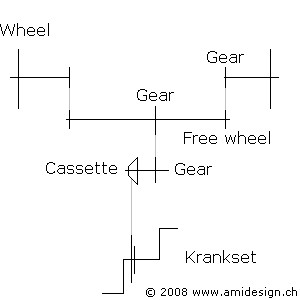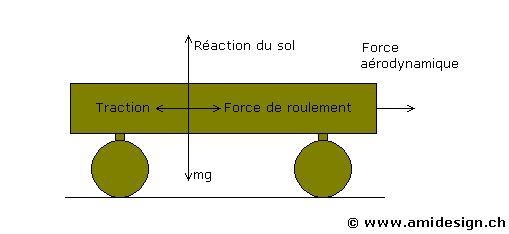Mecanics
Free wheels differential power train

Forces

When a vehicle runs on a plane surface it is submitted to two forces in opposition to the moving direction
The forces concerned
They are the aerodynamic load and the rolling force. The aerodynamic load can be divided into two forces: the force due to the body and the force due to the rotation of the wheels. The mass of the vehicle has to be taken into account for the calculation of the rolling force. The reaction of the ground is equal to m g (mass times terrestrial acceleration in newton). Rolling force formula
Fr = m g m'
- Fr Rolling force in N (newton)
- m Vehicle masse in kg
- g Terrestrial acceleration in m/s2
- m' Rolling friction coefficient without dimension ( m' car = 0.05 - m' bicycle = 0.005)
Dynamometer 25 kg
Measure of the rolling friction coefficient
Measurement is simply done with a commercial dynamometer. Its important to choose a plane surface for the vehicle. It is enough to attach a cord to the hook of towing. To attach the dynamometer and pull it until the vehicle moves. It is also necessary to know the mass of the vehicle.
m' = md / m
- m' Rolling friction coefficient
- md Measured mass with the dynamometer
- m Vehicle mass , for a bicycle, with the cyclist
For my recumbent bicycle ami-swb, I practised a little differently. As I do not have a dynamometer for this order of magnitude (0.5 to 1 kg). I took a measurement by using the pedal and masses. I sat down on the bicycle and I hung a bag at the pedal and I gradually loaded the bag until the bicycle advances. At this moment the bag was loaded with 1.825 kg. The ratio of the gear box is 0.75, the plate has 52 teeth and the pinion has 16. Thus the ratio of reduction gearing is 52/16 x 0.75 = 2.44 ; The lever of the pedal is 0.170 m and the fictitious pinion has a radius of 0.170/2.44 = 0.0697 m, That gives me a couple of 1.83 x 9.81 x 0.0697 = 1.249 Nm, The wheel has 0.25 m of radius, therefore the force on the wheels is 1.249/0.25 = 4.916 N. The bicycle and myself weights 99 kg, which makes 99 x 9.81 = 971.2 N. Now m' = 4.916/971.2 = 0.005062. This measurement includes all the kinematics chain: pedals unit, friction of the chain and friction of the gear box. It is a good thing because it indicates the net force needed for rolling.

